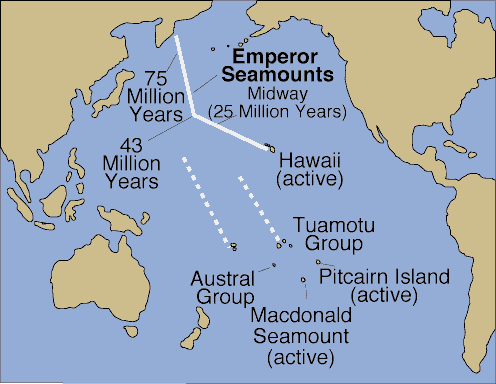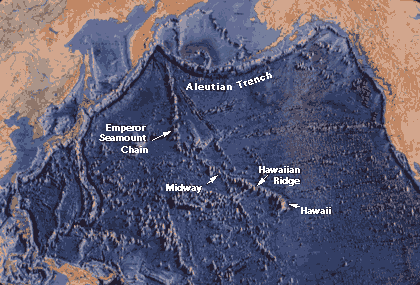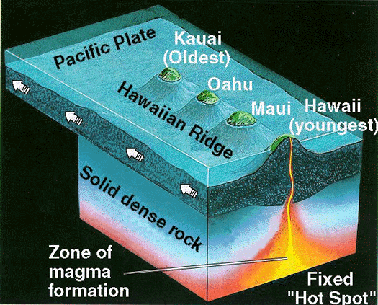Seamounts and the Hawaiian Hot Spot
In the 1960s, geologists were seeking ways to prove or disprove the new idea of
moving plates. Exploration of magnetic anomalies at mid-ocean ridges provided
strong support for seafloor spreading . Geologists studied other ocean features
to see how they related to plate tectonics. While visiting Hawaii, Tuzo Wilson,
one of the founders of the theory of plate tectonics, noticed some interesting
features about ocean islands. On a map of the Pacific basin, he found three
linear chains of volcanoes and submarine volcanoes (seamounts).
 Although separated by thousands of miles, the three linear chains are parallel
to each other. Of the three, the Hawaii-Emperor seamount chain was the most
well known. Wilson reviewed the reports that had been published on these island
chains and recorded the age of each island. An interesting pattern emerged. For
each chain, the islands become progressively younger to the southeast. The
extreme southeast end of each chain is marked by active volcanoes.
Although separated by thousands of miles, the three linear chains are parallel
to each other. Of the three, the Hawaii-Emperor seamount chain was the most
well known. Wilson reviewed the reports that had been published on these island
chains and recorded the age of each island. An interesting pattern emerged. For
each chain, the islands become progressively younger to the southeast. The
extreme southeast end of each chain is marked by active volcanoes.

Wilson proposed that the Hawaiian islands formed successively over a common
source of magma called a hot spot. The Island of Hawaii is currently located
above the hot spot.
 Hot, solid rock rises to the hot spot from greater depths. Due to the lower
pressure at the shallower depth, the rock begins to melt, forming magma. The
magma rises through the Pacific Plate to supply the active volcanoes. The older
islands were once located above the stationary hot spot but were carried away
as the Pacific Plate drifted to the northwest .
Hot, solid rock rises to the hot spot from greater depths. Due to the lower
pressure at the shallower depth, the rock begins to melt, forming magma. The
magma rises through the Pacific Plate to supply the active volcanoes. The older
islands were once located above the stationary hot spot but were carried away
as the Pacific Plate drifted to the northwest .
(from http://volcano.und.nodak.edu/vwdocs/vwlessons/hotspots.html)



